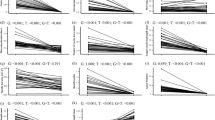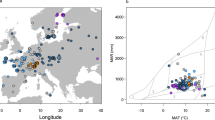Abstract
Phenotypic plasticity (the pattern of response of organisms to changes in environmental conditions) and phenotypic integration (the pattern of character correlations) are important components of our understanding of the evolution of complex phenotypes. Most studies published so far in this area have been conducted within populations with the express aim of predicting future response to evolutionary forces. However, among-population differentiation for plasticity and trait correlations are important indicators of recent past events that have shaped the currently observable phenotypes. We investigated variation in the reaction norms of several traits in a large number of accessions of Arabidopsis thaliana exposed to different levels of light quantity as well as the environmental lability of the corresponding across-population character variance–covariance matrix. Our results show that there is an astounding degree of inter-population variation for character means and very little variation for plasticity, in agreement with the idea that A. thaliana is a light-specialist often occurring in open, disturbed habitats. However, this plant also shows patterns of plasticity that are predicted to be adaptive based on functional ecological considerations, such as an increase in either specific leaf area or leaf number (but not both) under low light. We also demonstrate that the set of character correlations in A. thaliana is extremely stable to changes in light availability, contrary to previous findings in the same species when different environmental factors were considered. Several processes that might have been responsible for the observed patterns are discussed as a prelude to follow-up research on these problems.
Similar content being viewed by others
References
Aastveit, A.H. and Aastveit, K. (1993) Effects of genotype-environment interactions on genetic correlations. Theor. Appl. Genet. 86, 1007–1013.
Ackerly, D.D. and Donoghue, M.J. (1998) Leaf size, sapling allometry, and Corner's rules: phylogeny and correlated evolution in maples (Acer). The Am. Nat. 152, 767–791.
Alonso-Blanco, C., El-Assal, S.E.-D., Coupland, G. and Koornneef, M. (1998) Analysis of natural allelic variation at flowering time loci in the Landsberg erecta and Cape Verde Islands ecotypes of Arabidopsis thaliana. Genetics 149, 749–764.
Anderson, M. and Roberts, J.A. (1998) Arabidopsis. Sheffield Academic Press, Sheffield, England.
Andersson, S. and Shaw, R.G. (1994) Phenotypic plasticity in Crepis tectorum (Asteraceae): genetic correlations across light regimens. Heredity 72, 113–125.
Armbruster, W.S. and Schwaegerle, K.E. (1996) Causes of covariation of phenotypic traits among populations. J. Evol. Biol. 9, 261–277.
Ballare, C.L. (1999) Keeping up with the neighbours: phytochrome sensing and other signalling mechanisms. Trends Plant Sci. 4, 97–102.
Barton, N. and Partridge, L. (2000) Limits to natural selection. BioEssays 22, 1075–1084.
Bell, G. (1992) The ecology and genetics of fitness in Clamydomonas. V. The relationship between genetic correlation and environmental variance. Evolution 46, 561–565.
Bell, G. and Reboud, X. (1997) Experimental evolution in Chlamydomonas II. Genetic variation in strongly contrasted environments. Heredity 78, 498–506.
Bradshaw, A.D. (1972) Some of the evolutionary consequences of being a plant. Evol. Biol. 6, 25–47.
Byers, D.L. and Quinn, J.A. (1998) Demographic variation in Alliaria petiolata (Brassicaceae) in four contrasting habitats. J. Torrey Bot. Soc. 125, 138–149.
Callahan, H. and Pigliucci, M. (in press) Shade-induced plasticity and its ecological significance in wild populations of Arabidopsis thaliana. Ecology.
Callahan, H.S., Wells, C.L. and Pigliucci, M. (1999) Light-sensitive plasticity genes in Arabidopsis thaliana: mutant analysis and ecological genetics. Evol. Ecol. Res. 1, 731–751.
Camara, M. and Pigliucci, M. (1999) Mutational contributions to genetic variance/covariance matrices: an experimental approach using induced mutations in Arabidopsis thaliana. Evolution 53, 1692–1703.
Camara, M.D., Ancell, C.A. and Pigliucci, M. (2000) Induced mutations: a novel tool to study phenotypic integration and evolutionary constraints in Arabidopsis thaliana. Evolutionary Ecol. Res. 2, 1009–1029.
Cheverud, J.M. (1984) Quantitative genetics and developmental constraints on evolution by selection. J. Theor. Biol. 110, 155–171.
Dorn, L.A., Pyle, E.H. and Schmitt, J. (2000) Plasticity to light cues and resources in Arabidopsis thaliana: testing for adaptive value and costs. Evolution 54, 1982–1994.
Dudley, S.A. and Schmitt, J. (1996) Testing the adaptive plasticity hypothesis: density-dependent selection on manipulated stem length in Impatiens capensis. The Am. Nat. 147, 445–465.
Eisen, E.J. and Saxton, A.M. (1983) Genotype by environment interactions and genetic correlations involving two environmental factors. Theor. Appl. Genet. 67, 75–86.
Galen, C. (2000) High and dry: drought stress, sex-allocation trade-offs, and selection on flower size in the alpine wildflower Polemonium viscosum (Polemoniaceae). The Am. Nat. 156, 72–83.
Gould, S.J. (1966) Allometry and size in ontogeny and phylogeny. Biol. Rev. 41, 587–640.
Hansen, T.F. and Martins, E.P. (1996) Translating between microevolutionary process and macroevolutionary patterns: the correlation structure of interspecific data. Evolution 50, 1404–1417.
Klingenberg, C.P., Badyaev, A.V., Sowry, S.M. and Beckwith, N.J. (2001) Inferring developmental modularity from morphological integration: analysis of individual variation and asymmetry in bumblebee wings. The Am. Nat. 157, 11–23.
Klingenberg, C.P. and Zimmermann, M. (1992) Static, ontogenetic, and evolutionary allometry: a multivariate comparison in nine species of water striders. The Am. Nat. 140, 601–620.
Kunkel, B.N. (1996) A useful weed put to work: genetic analysis of disease resistance in Arabidopsis thaliana. Trends Genet 12, 63–69.
Lande, R. (1979) Quantitative genetic analysis of multivariate evolution, applied to brain:body size allometry. Evolution 33, 402–416.
Lande, R. and Arnold, S.J. (1983) The measurement of selection on correlated characters. Evolution 37, 1210–1226.
Lasceve, G., Leymarie, J., Olney, M.A., Liscum, E., Christie, J.M., Vavasseur, A. and Briggs, W.R. (1999) Arabidopsis contains at least four independent blue-light-activated signal transduction pathways. Plant Physiol. 120, 605–614.
Merila, J. and Bjorklund, M. (1999) Population divergence and morphometric integration in the Greenfinch (Carduelis chloris) - evolution against the trajectory of least resistance? J. Evol. Biol. 12, 103–112.
Mezey, J.G., Cheverud, J.M. and Wagner, G.P. (2000) Is the genotype-phenotype map modular? A statistical approach using mouse Quantitative Trait Loci data. Genetics 156, 305–311.
Mitchell-Olds, T. (1996a) Genetic constraints on life-history evolution: quantitative-trait loci influencing growth and flowering in Arabidopsis thaliana. Evolution 50, 140–145.
Mitchell-Olds, T. (1996b) Pleiotropy causes long-term genetic constraints on life-history evolution in Brassica rapa. Evolution 50, 1849–1858.
Newman, R.A. (1994) Genetic variation for phenotypic plasticity in the larval life history of spadefoot toads (Scaphiopus couchii). Evolution 48, 1773–1785.
Nooden, L.D., Hillsberg, J.W. and Schneider, M.J. (1996) Induction of leaf senescence in Arabidopsis thaliana by long days through a light-dosage effect. Physiol. Plantarum 96, 491–495.
Nunez-Olivera, E., Martinez-Abaigar, J. and Escudero, J.C. (1996) Adaptability of leaves of Cistus ladanifer to widely varying environmental conditions. Funct. Ecol. 10, 636–646.
Petrov, A.P. and Petrosov, V.A. (1981) Variability in some lines of Arabidopsis thaliana (L.) Heynh. under different lighting conditions. Genetika 16, 1596–1602.
Phillips, P.C. and Arnold, S.J. (1999) Hierarchical comparison of genetic variance-covariance matrices. I. Using the Flury hierarchy. Evolution 53, 1506–1515.
Pigliucci, M. (1998) Ecological and evolutionary genetics of Arabidopsis. Trends Plant Sci. 3, 485–489.
Pigliucci, M. (in press) Touchy and bushy: phenotypic plasticity and integration in response to wind stimulation in Arabidopsis thaliana. Int. J. Plant Sci.
Pigliucci, M. and Kaplan, J. (2000) The fall and rise of Dr Pangloss: adaptationism and the Spandrels paper 20 years later. Trends Ecol. Evol. 15, 66–70.
Pigliucci, M. and Schlichting, C.D. (1995) Reaction norms of Arabidopsis (Brassicaceae). III. Response to nutrients in 26 populations from a worldwide collection. Am. J. Bot. 82, 1117–1125.
Pigliucci, M. and Schlichting, C.D. (1996) Reaction norms of Arabidopsis. IV. Relationships between plasticity and fitness. Heredity 76, 427–436.
Pigliucci, M. and Schlichting, C.D. (1998) Reaction norms of Arabidopsis. V. Flowering time controls phenotypic architecture in response to nutrient stress. J. Evol. Biol. 11, 285–301.
Pigliucci, M., Schlichting, C.D., Jones, C.S. and Schwenk, K. (1996) Developmental reaction norms: the interactions among allometry, ontogeny and plasticity. Plant Species Biol. 11, 69–85.
Pigliucci, M., Whitton, J. and Schlichting, C.D. (1995) Reaction norms of Arabidopsis. I. Plasticity of characters and correlations across water, nutrient and light gradients. J. Evol. Biol. 8, 421–438.
Rice, W.R. (1989) Analyzing tables of statistical tests. Evolution 43, 223–225.
Riska, B. (1991) Regression models in evolutionary allometry. The Am. Nat. 138, 283–299.
Roff, D. (2000) The evolution of the G matrix: selection or drift? Heredity 84, 135–142.
Scheiner, S.M. (1993) Genetics and evolution of phenotypic plasticity. Ann. Rev. Ecol. Systematics 24, 35–68.
Schlichting, C.D. (1989) Phenotypic integration and environmental change. BioScience 39, 460–464.
Schlichting, C.D. and Levin, D.A. (1986) Phenotypic plasticity: an evolving plant character. Biol. J. Linn. Soc. 29, 37–47.
Schlichting, C.D. and Pigliucci, M. (1993) Evolution of phenotypic plasticity via regulatory genes. The Am. Nat. 142, 366–370.
Schlichting, C.D. and Pigliucci, M. (1998) Phenotypic Evolution, a Reaction Norm Perspective. Sinauer, Sunderland, MA.
Schmalhausen, I.I. (1949) Factors of Evolution. The Theory of Stabilizing Selection. University of Chicago Press, Chicago.
Schmitt, J., Dudley, S. and Pigliucci, M. (1999) Manipulative approaches to testing adaptive plasticity: phytochrome-mediated shade avoidance responses in plants. The Am. Nat. 154, S43–S54.
Service, P.M. and Rose, M.R. (1985) Genetic covariation among life-history components: the effect of novel environments. Evolution 39, 943–945.
Shaw, F.H., Shaw, R.G., Wilkinson, G.S. and Turelli, M. (1995) Changes in genetic variances and covariances: G whiz! Evolution 49, 1260–1267.
Shirley, M.D.F. and Sibly, R.M. (1999) Genetic basis of a between-environment trade-off involving resistance to cadmium in Drosophila melanogaster. Evolution 53, 826–836.
Sills, G.R. and Nienhuis, J. (1995) Maternal phenotypic effects due to soil nutrient levels and sink removal in Arabidopsis thaliana (Brassicaceae). Am. J. Bot. 82, 491–495.
Simons, A.M. and Roff, D.A. (1996) The effect of a variable environment on the genetic correlation structure in a field cricket. Evolution 50, 267–275.
Sokal, R.R. and Rohlf, F.J. (1995) Biometry. Freeman & Co., New York, NY.
Steppan, S.J. (1997) Phylogenetic analysis of phenotypic covariance structure. I. Contrasting results from matrix correlation and common principal component analyses. Evolution 51, 571–586.
Stratton, D.A. and Bennington, C.C. (1996) Measuring spatial variation in natural selection using randomly-sown seeds of Arabidopsis thaliana. J. Evol. Biol. 9, 215–228.
Sultan, S.E. (1995) Phenotypic plasticity and plant adaptation. Acta Bot. Neederl. 44, 363–383.
SYSTAT. 2000. SYSTAT 10.0 for Windows. SPSS Inc., Chicago.
Tatar, M. and Carey, J.R. (1995) Nutrition mediates reproductivity trade-offs with age-specific mortality in the beetle Callosobruchus maculatus. Ecology 76, 2066–2073.
Travisano, M., Mongold, J.A., Bennett, A.F. and Lenski, R.E. (1995) Experimental tests of the roles of adaptation, chance, and history in evolution. Science 267, 87–90.
Turelli, M. (1988) Phenotypic evolution, constant covariances, and the maintenance of additive variance. Evolution 42, 1342–1347.
Via, S. (1987) Genetic constraints on the evolution of phenotypic plasticity. In V. Loeschcke (ed) Genetic Constraints on Adaptive Evolution. Springer-Verlag, Berlin. pp. 47–71.
Via, S. (1993) Adaptive phenotypic plasticity: target or by-product of selection in a variable environment? The Am. Nat. 142, 352–365.
Wagner, G.P. (1995) Adaptation and the modular design of organisms. In F. Moran, A. Moreno, J.J. Merelo and P. Chacon (eds) Advances in Artificial Life. Springer, Berlin. pp. 317–328.
Wagner, G.P. and Schwenk, K. (2000) Evolutionarily stable configurations: functional integration and the evolution of phenotypic stability. Evol. Biol. 31, 155–217.
Waitt, D.E. and Levin, D.A. (1993) Phenotypic integration and plastic correlations in Phlox drummondii (Polemoniaceae). Am. J. Bot. 80, 1224–1233.
Weinig, C. (2000) Differing selection in alternative competitive environments: shade-avoidance responses and germination timing. Evolution 54, 124–136.
Whitelam, G.C. and Devlin, P.F. (1998) Light signalling in Arabidopsis. Plant Physiol. Biochem. 36, 125–133.
Whitelam, G.C., Patel, S. and Devlin, P.F. (1998) Phytochromes and photomorphogenesis in Arabidopsis. Phil. Trans. Roy. Soc. London B, 353, 1445–1453.
Windig, J.J. (1994) Genetic correlations and reaction norms in wing pattern of the tropical butterfly Bicyclus anynana. Heredity 73, 459–470.
Winn, A.A. (1999) Is seasonal variation in leaf traits adaptive for the annual plant Dicerandra linearifolia? J. Evol. Biol. 12, 306–313.
Wolf, J.B., Frankino, W.A., Agrawal, A.F., III E.D. Brodie and Moore, A.J. (2001) Developmental interactions and the constituents of quantitative variation. Evolution 55, 232–245.
Yamaguchi-Shinozaki, K., Urao, T. and Shinozaki, K. (1995) Regulation of genes that are induced by drought stress in Arabidopsis thaliana. J. Plant Res. 108, 127–136.
Author information
Authors and Affiliations
Corresponding author
Rights and permissions
About this article
Cite this article
Pigliucci, M., Kolodynska, A. Phenotypic plasticity to light intensity in Arabidopsis thaliana: invariance of reaction norms and phenotypic integration. Evolutionary Ecology 16, 27–47 (2002). https://doi.org/10.1023/A:1016073525567
Issue Date:
DOI: https://doi.org/10.1023/A:1016073525567




